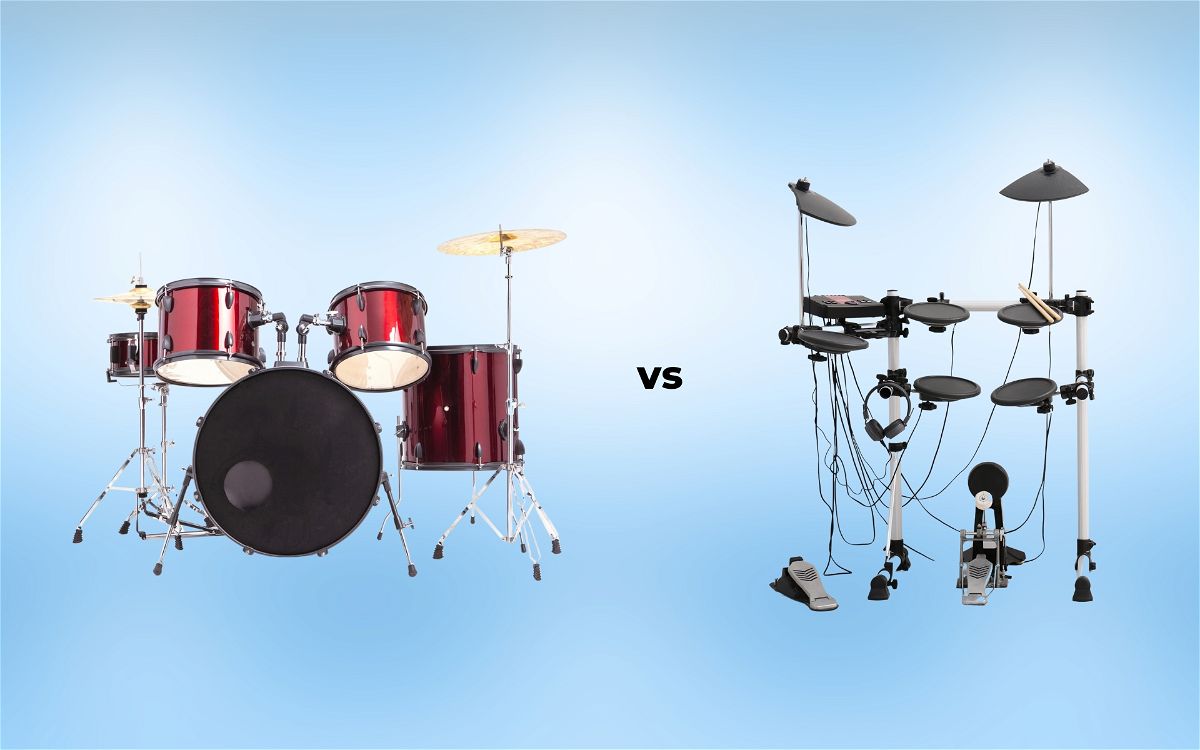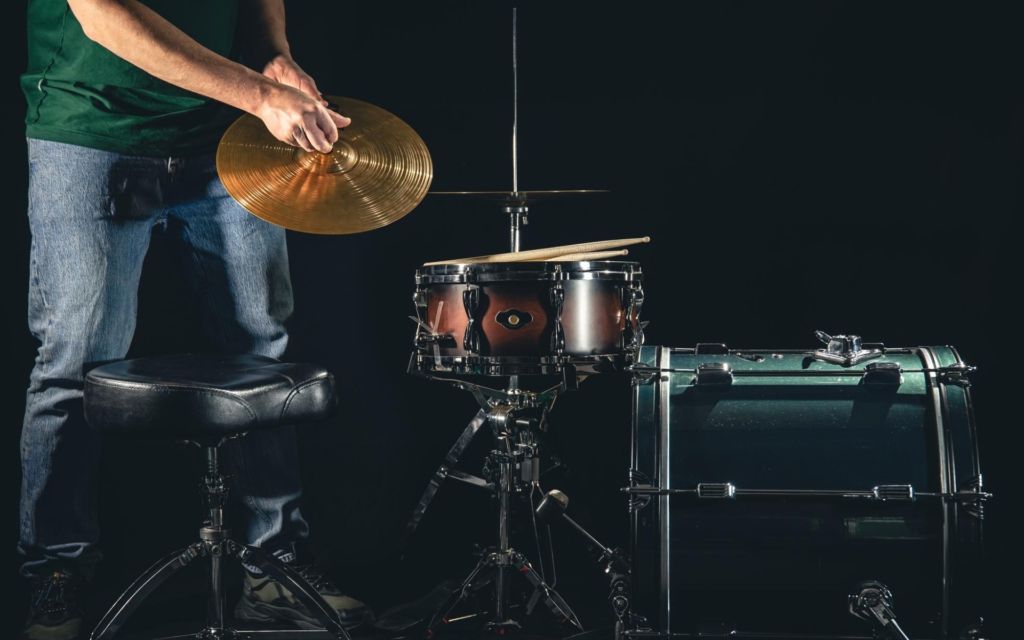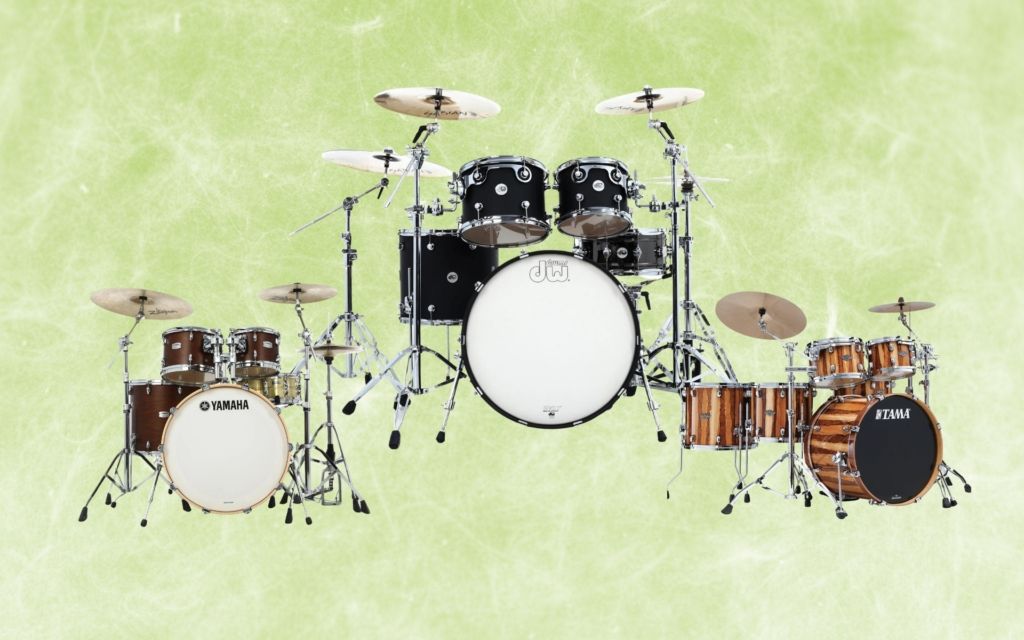Drum kits are divided into two main categories – acoustic and electronic drum sets. While acoustic kits are what most people identify with, electronic drum sets have been getting more popular every passing year.
There are dozens of similarities between the two types, but also several differences that are very important to know about.
Here’s an ultimate guide to understanding all the differences between acoustic vs electric drums. I’ll mention the benefits and drawbacks of both, and then I’ll explain which type you should choose if you’re looking to buy a new drum set.
Contents
Electronic vs Acoustic Drums at a Glance
Both electronic and acoustic drums are excellent tools for modern drummers, and it’s important to note that neither is strictly better than the other.
They both serve different purposes and have their own benefits and drawbacks.
Here’s a quick table comparing all the main differences between clear and coated drum heads.
| Feature | Electronic Drums | Acoustic Drums |
|---|---|---|
| Playability | Quite fun but not as realistic. | A lot more realistic and enjoyable to play. |
| Noise | Much quieter than real drums. | Very loud and advised to wear hearing protection. |
| Space | Takes up half the space of a real drum set. | Takes up a large space, approx 1.5x2 metres. |
| Practice | Excellent for practice and doesn't disturb others. | Good for practice but noise levels can limit time and progress. |
| Live Performance | Not as exciting or fun to play for live shows. | A lot better to play at live concerts. |
| Recording | Good for recording demos but not real studio performances. | Superb in the recording studio to obtain natural drum and cymbal tones. |
Acoustic Drums
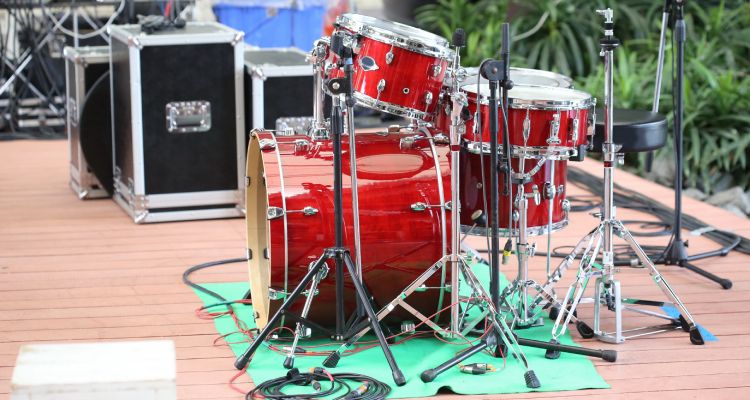
Components of an Acoustic Drum Set
Acoustic drum kits consist of shells, cymbals, and hardware. The big defining factor of them is that you can play them without needing any electronics.
The drum shells are either made from wood or metal. You’ll mostly find toms and bass drums made from wood, whereas many snares are made from metal.
Each acoustic drum shell comprises of a body, bearing edges where the shell has been shaped to seat the drumheads, and a set of rims to hold the drumheads in place. Those rims get attached using lugs and tension screws.
The way the shells have been created determines how they sound acoustically. Different woods offer various tonal qualities, like maple offering warm tones and birch producing slightly more aggressive tones.
Drum sets also feature Cymbals that are made from metal. The cheapest ones are made from cuts of brass, whereas most decent cymbals are made from bronze. The sounds of cymbals depend on how they’ve been lathed, hammered, and manipulated in the production process.
Hardware stands such as cymbal stands and snare drum stands are also made from metal, and they’re used to hold all the drums and cymbals in place.
Uses for Acoustic Drum Kits
Acoustic drum kits are the go-to option for drummers. They’re the default version of what everyone wants a drummer to play for gigs, whereas electronic kits are designed to be replicated versions of acoustic kits.
When someone starts playing the drums, an acoustic kit is the main instrument that they need to learn to use. It will offer the most authentic playing experience, and every drumming technique is geared toward playing acoustic drums.
Benefits of Acoustic Drum Kits
Acoustic drums are the real deal. They look fantastic and they feel even better to play. In my opinion, while electronic drums are amazing tools, you can’t replicate the feeling of playing on a high-quality full-sized acoustic drum set.
When using an acoustic kit at a live gig, you can get a lot more energy out of the instrument when playing.
It does a great job of giving back exactly what you put in, and the feeling of a large bass drum thumping through your chest is irreplaceable.
Another big benefit of playing an acoustic drum kit is that you don’t need any external components or power to be able to play.
Acoustic kits are cheaper than electronic kits, for the most part. You can get a much better sounding kit for a lower price, and you can tune the drums to sound as good as possible. A lot of drummers are easily able to make cheap acoustic kits sound decent.
The expandability of acoustic kits is another huge benefit. If you want more pieces in your setup, you just need to buy them and get stands to hold them.
A final major benefit of acoustic drum kits is that there are dozens of different types and finishes available. You can make your kit feel very personal to you by choosing a finish that you love and that not many other people have.
Drawbacks of Acoustic Drum Kits
Everybody knows this, but you can’t understate how loud acoustic drums are. That’s their biggest flaw.
They’re so loud that many drummers can’t have them in their houses unless they have soundproofing as playing would seriously bother everyone around them.
You can get low-volume cymbals and drumheads, but those don’t produce great tones. They’re more of a practice option.
When you buy intermediate and professional acoustic drum sets, they only come as shell packs. They don’t even include a snare drum most of the time.
Drummers who buy these shell packs need to make sure that they already have all the other components needed to set up a full kit. Otherwise, they need to pay extra cash to buy them.
Acoustic kits are also quite large. All of them have big footprints. You get a few compact options, but even those tend to be bigger than electronic kits when you have them set up with hardware and cymbals.
Electronic Drums
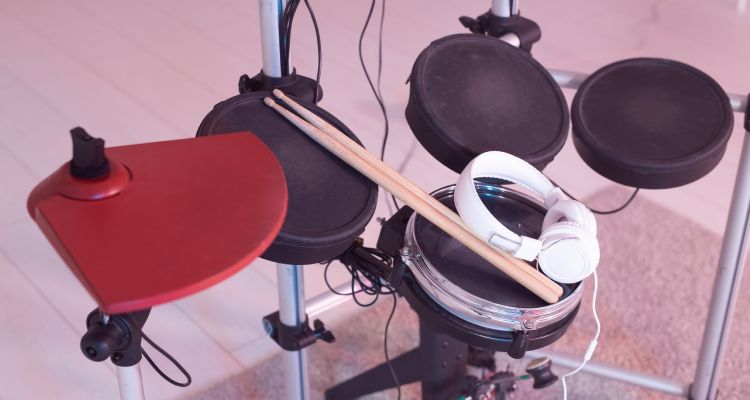
Components of an Electronic Drum Kit
All electronic drum sets consist of drum and cymbal pads, hardware, a drum module, and cables to plug all the pads into the drum module.
The biggest differentiating factor between these and acoustic drums is that you need power to run electronic kits.
You also need to have some sort of source for the sounds to play through. That could either be headphones or an amp. If you use headphones, only you’ll be able to hear what you’re playing. An amp will play the sounds out for everyone around you to hear.
E-kits don’t need as much hardware to hold everything together, as most of the components are attached to a single rack. You do need to buy a drum throne and kick pedal separately when you buy most e-kits, though.
When it comes to drum pads, all electronic kits have mesh, rubber, or silicone pads.
Mesh pads have thousands of small holes to diffuse vibrations. This makes them feel more like acoustic drumheads than rubber pads do. Silicone pads are very similar.
Rubber pads come on cheaper kits, and they have much more rebound when you strike them with sticks.
Uses for Electronic Drum Kits
The main idea behind using an electronic kit is that it’s a lot softer than an acoustic kit. They’re great for practicing without bothering anyone around you. You’ll still hear the tapping of pads, but it won’t be nearly as loud as a full-on acoustic drum kit being played.
Electronic kits can also be used to play electronic sounds that are impossible to produce with acoustic drums.
Benefits of Electronic Drum Kits
Having the ability to control volume is the biggest benefit that electronic drums offer. You can play the drums through an amp for people around you to hear, but you can then lower the volume with a knob to suit whatever environment you’re in.
Another major benefit of using an electronic kit is that it’s much easier to record than an acoustic kit. You simply need to plug a USB cable into a computer, whereas acoustic kits need a recording interface and multiple microphones.
The drum sounds coming from an electronic kit are already mixed and mastered. The sounds coming through acoustic drum kit microphones need to be tweaked to get the best mix possible. Anyone can record easily on an e-kit, but recording drums on an acoustic kit requires a whole new set of skills.
Finally, you could argue that you get a lot more value for your money from an electronic kit. You get everything you need apart from a throne and kick pedal when you buy one, and all drum modules offer dozens of different drum kit sounds.
Drawbacks of an Electronic Drum Set
The first and biggest thing to mention is that the sounds coming from electronic kits will never be as good as the ones from acoustic kits. It has to do with the pad sensitivity and triggers. Electronic kits always sound digital, no matter how much they try to emulate acoustic drums.
They’ve gotten better as technology has advanced, but electronic drum brands still haven’t cracked the code just yet.
Another huge drawback is that your technique can suffer if you only play on an electronic kit. You don’t need to worry about dynamic control as much when playing an e-kit, and that lack of control will make you sound worse when you play an acoustic kit.
The higher-priced electronic kits are better for you in these areas, but that’s the next drawback. Electronic drum sets are expensive.
There are several decent options for beginners that are affordable, but you’ll only get decent sound quality and playability when spending $1000 or more.
How to Choose Between Acoustic or Electric Drums
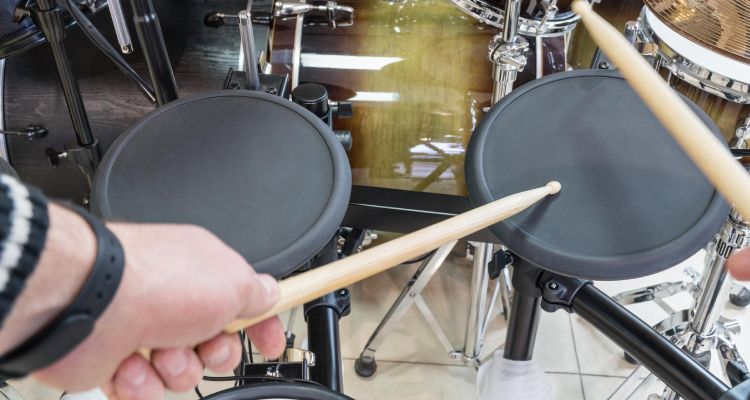
Environment
Environment will be your biggest deciding factor. If you’re unable to make a lot of noise where you live, an electronic kit is your only option.
However, electronic kits are often just easier purchases for beginner drummers. So, you should also consider one if you live somewhere where you can make a bit of noise.
If you want to eventually start playing gigs with your kit, you’ll need to get an acoustic set. It’s fine to play a gig with an electronic kit, but the crowd will always notice the bad sound quality if it’s not a high-end kit.
Budget
Budget is another big point to consider. If you only have $500 to spend, you’ll need to get an electronic kit. Kits from brands like Alesis and Behringer are very inexpensive, and they’re relatively decent options for a drummer just starting out.
If you have between $500 and $1000, I’d suggest getting an acoustic set if you can. There are dozens of good entry-level options that come with hardware and cymbals included.
If your budget is higher than that, it’s up to you where to put your money. Your environment will be the deciding factor at that point.
Hybrid Drum Kits
One last point to mention is hybrid drum kits. These are drum sets that include both acoustic and electronic components.
Instead of thinking of electronic drums vs acoustic, these have electronic drums with acoustic drums. You get the best of both worlds here, as the electronic parts will allow you to play digital sounds that may be needed for certain songs. You’ll see most pop drummers using hybrid setups like this.
People often refer to the electronic drums with acoustic shells as hybrid kits, but that’s a bit of misinformation, considering that all those kits are fully electronic.
Final Thoughts on Acoustic Drums vs Electronic Drums
Electronic and acoustic drum kits have been living side-by-side for decades now. You’ll get the best out of both of them if you use both of them.
Most drummers use electronic kits for practicing and acoustic kits for gigging. However, there are distinct pros and cons to both, and it’s up to you to make the best of those.
I highly recommend using an acoustic kit mainly, as that’s what drumming is mostly centered around. But a good electronic kit will serve you well too.

